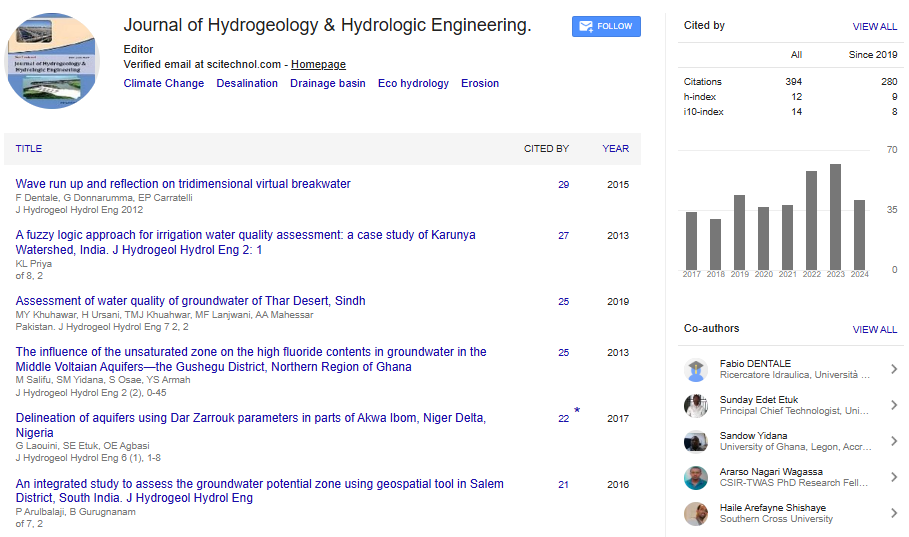Commentary, J Hydrogeol Hydrol Eng Vol: 13 Issue: 3
Soil Porosity: Recognizing the Secret Areas Using Human Feet
Sybil Sharvelle*
1Department of Civil & Environmental Engineering, University of New South Wales, Sydney, Australia
*Corresponding Author: Sybil Sharvelle,
Department of Civil & Environmental
Engineering, University of New South Wales, Sydney, Australia
E-mail: sharvelle37@gmail.com
Received date: 27 May, 2024, Manuscript No. JHHE-24-144603;
Editor assigned date: 30 May, 2024, PreQC No. JHHE-24-144603 (PQ);
Reviewed date: 13 June, 2024, QC No. JHHE-24-144603;
Revised date: 21 June, 2024, Manuscript No. JHHE-24-144603 (R);
Published date: 28 June, 2024, DOI: 10.4172/2325-9647.1000324
Citation: Sharvelle S (2024) Soil Porosity: Recognizing the Secret Areas Using Human Feet. J Hydrogeol Hydrol Eng 13:3.
Description
Soil porosity refers to the fraction of the volume of soil that is not occupied by solid particles. It is a measure of the spaces, or pores, within soil, which can be filled with air or water. This characteristic is essential for various soil functions, including water retention, root penetration, and microbial activity. Understanding soil porosity is essential for agriculture, environmental management, and civil engineering. Soil is a complex mixture of minerals, organic matter, gases, liquids, and countless organisms that together support life on Earth. The solid particles in soil consist of sand, silt, and clay, while the pore spaces are occupied by water and air. Soil porosity is influenced by several factors, including soil texture, structure, organic matter content, and compaction.
Soil texture, which is the relative proportions of sand, silt, and clay, significantly affects soil porosity. Sandy soils have larger particles and larger pore spaces, leading to higher porosity. However, the pores are often less connected, affecting water retention. Clay soils, on the other hand, have smaller particles and smaller pore spaces but tend to have a higher total porosity due to the large number of microspores. Soil structure refers to the arrangement of soil particles into aggregates. Well-structured soils have stable aggregates that create a range of pore sizes, enhancing porosity. Poorly structured soils may have compacted, aggregated particles that reduce porosity. Organic matter improves soil porosity by binding soil particles into aggregates and creating pore spaces as it decomposes. High organic matter content typically leads to better soil structure and increased porosity. Soil compaction reduces porosity by pressing soil particles closer together, eliminating pore spaces. This can occur due to heavy machinery, livestock trampling, or even foot traffic. Compacted soils have reduced infiltration rates, poor root growth, and limited gas exchange.
These are large pores, typically greater than 0.08 mm in diameter. They are essential for water drainage and air movement. Macrospores allow for rapid water movement and are usually found in sandy soils or well-structured soils. These pores range from 0.03 mm to 0.08 mm in diameter. They retain water that is readily available to plants and are vital for plant growth. These are small pores, less than 0.03 mm in diameter. They hold water tightly, making it less available to plants. Clay soils typically have a high proportion of microspores. Soil porosity influences how water moves through and is stored in the soil. High porosity allows for better infiltration and drainage, reducing runoff and erosion. It also affects the soil’s ability to retain moisture, which is essential for plant growth. Adequate pore space is necessary for root expansion and penetration. Compacted or poorly structured soils with low porosity can restrict root growth, limiting access to water and nutrients. Soil pores filled with air are essential for root respiration and microbial activity. Proper aeration promotes healthy root systems and the breakdown of organic matter. Soil porosity creates habitats for microorganisms. These microorganisms are vital for nutrient cycling and organic matter decomposition, enhancing soil fertility.
Conclusion
Soil porosity is a fundamental property that influences many aspects of soil health and functionality. Understanding the factors that affect soil porosity and the methods for measuring it can help in managing soil for agricultural productivity, environmental sustainability, and engineering applications. By maintaining or improving soil porosity through practices such as reducing compaction, increasing organic matter, and fostering good soil structure, we can ensure that soils continue to support plant growth and ecosystem health.
 Spanish
Spanish  Chinese
Chinese  Russian
Russian  German
German  French
French  Japanese
Japanese  Portuguese
Portuguese  Hindi
Hindi 
